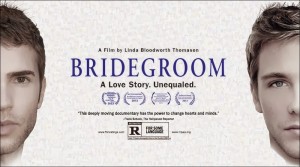 Bridegroom. Dir. Linda Bloodworth-Thomason. Virgil Films & Entertainment. 2013. 80 min.
Bridegroom. Dir. Linda Bloodworth-Thomason. Virgil Films & Entertainment. 2013. 80 min.
The stirring documentary “Bridegroom” depicts the complicated coming-out processes of its two subjects, Shane Crone and Thomas Bridegroom, their charming, deeply loving relationship, and the complex tragedy that unfolds after Bridegroom’s accidental death and his family’s subsequent shunning of Crone. The film impressively and laudably, though not always subtly, serves as a plea for respect, empathy, and love in a society that does not necessarily extend those virtues toward LGBT couples.
The abundance of home video footage and heartfelt friend and family interviews creates a vivid picture of two distinct, loving, and creative men who left a profoundly positive impact on each other and those around them over many years. As important, we also get a crystal clear picture of how, despite their deeply similar families and backgrounds, Shane’s family is much more prepared to accept his sexuality than Thomas’s ever can. This disparity comes sharply in play when Thomas and Shane’s truly endearing love story is abruptly cut short by Thomas’s sudden and tragic death.
“Bridegroom” is at its most effective in the immediate aftermath of this tragedy. As Thomas’s family begins to shut Shane and his family and friends out of the funeral proceedings, the reactions of those suddenly outcast run a wide gamut of hurt, anger, fear, and sad acceptance. Put together, these interviews make a compelling and heartbreaking point about the fundamental indignity of marriage inequality.
As the film appeals heavily to empathy and emotion, it occasionally veers towards oversentimentality. As it tugs at the heartstrings, the musical score, while tonally understandable, feels manipulative and too often becomes overbearing and distracting. The events are affecting enough without such overt musical and editing cues. At times, one wishes the filmmaker had chosen a more subtle route.
Production quibbles aside, however, this is an important film and one to be actively sought out. It is highly recommended for public, academic and school libraries catering to viewers of middle school age and above. Its R rating (for “some language,”–an infuriatingly vague notion) is, frankly, a crock. There are no more than two or three thorny exclamations scattered throughout the presentation. Parents or educators might want to preview the film before showing this film to younger viewers, but non-prejudiced general audiences would find next to nothing truly scandalous or objectionable. This film is, at its core, a compelling and emotional conversation starter – one that has the potential to affect the beliefs and worldviews of its viewers.
Reviewer: Michael Mungin
Psychology Liaison Librarian, James Madison University
